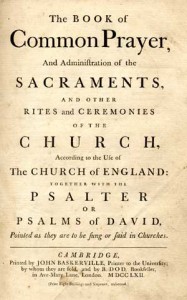To be sure, the American Church adopted a new, heavily revised Prayer Book in the wake of the Revolution. But this really had nothing to do with any genuine dissatisfaction with the 1662 BCP.
Besides, but most of the other English speaking churches—Methodist, Presbyterian, Baptist and Congregational—that used the 1662 book either in whole or part continued worshipping with it into the 20th Century.
Anglicans have traditionally been conservative in their modes of worship. The 1662 BCP was the book with which George Washington was familiar. And it was so popular with both clergy and laity it remained in widespread use through the opening decade of the 19th Century.
A reason for this is that the 1662 liturgies of the Eucharist and the Offices of Morning and Evening Prayer are far more succinct than those of the Prayer Book of 1796.
The 1928 Eucharistic Liturgy remains virtually unchanged from that of the 1796 BCP. This Rite is directly derived from the Scottish Communion Rite adopted by the American Church at the urging of Samuel Seabury, America’s first Episcopal bishop. Seabury was consecrated in Aberdeen, Scotland, on November 14, 1784, with the condition that he work for the adoption of the Scottish rite rather than the English rite of 1662.
Yet the structure of the 1662 Eucharist is simple, straightforward, and economical. The 1796/1928 Rite, by contrast, is complex, prolix, and repetitive. Among other things, the 1928 version incorporates both long post communion thanksgiving prayers designated as alternatives in the 1662 Rite.
The 1662 is often wrongly accused of being “too protestant” and failing to express adequately the faith catholic. This is a curious criticism of a liturgy in which the Canon of Consecration ends with our Lord’s Words of Institution: “This is my body … This is my blood …”
Critics also claim that the 1662 Rite lacks an Epiclesis—the invocation of the Holy Spirit on the Eucharistic bread and wine. It does, in fact, have an Epiclesis. However, it precedes our Lord’s Words of Institution, while in older liturgies it follows them.
It seems reasonable to suppose Cranmer repositioned the Epiclesis because it seems illogical—and, perhaps, even a tad sacrilegious—to invoke the Holy Spirit upon elements already consecrated with our Lord’s Words of Institution.
The so-called “Black Rubric”, which declares kneeling to receive the Host at the Eucharist should not be interpreted as adoration of the Sacrament, also offends critics. (Its appellation “Black Rubric” arises not because it was considered evil but because, by printer’s error, it was printed in black rather than red.)
Aside from the fact that a rubric is not a creed, the Black Rubric was instituted for a not unreasonable purpose: It emphasized to a highly superstitious population that it is not the elements themselves that are being worshipped but Jesus IN the elements.
Perhaps there would better ways of doing this, but there is no point in arguing the pitch and toss about 16th Century issues when modern superstitions arise more from a supposed “real absence” than the nature of the “Real Presence.”
In any event, use of the Book of 1662 neither precludes nor replaces the Book of 1928. Both books are vital resources for traditionalist parishes, and they should be regarded as complementing each other rather than as rivals. GPH✠




“The Black Rubric” is not a Rubric that is to say a Liturgical Direction, and was entered without authority of Parliament.
Very well said Father Hastings, I should add that the choir offices of Mattins and Evensong flow better than the 1928 BCP and I never understood why the vesicles “O God make speed to save us” and the response, “O Lord make haste to help us” were left out.